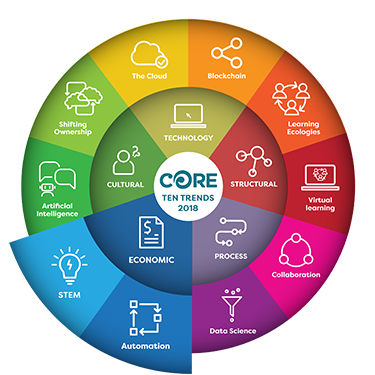STEM

What's it about?
There’s currently a surge of interest in programmes targeting Science, Technology, Engineering, and Maths (STEM), focusing on educators and others looking at where the jobs are right now and into the future. The critical thing about STEM education is that it is intended to be an interdisciplinary curriculum. Rather than teach these four disciplines as separate and discrete subjects, STEM integrates into “interdependent” learning units based on real-world applications
The drivers behind STEM are a significant contributor to the development in New Zealand, of the recently announced Digital Technologies Curriculum and the steady rise in interest and participation in initiatives such as the Maker Movement and Coding programmes in schools.
What's driving this?
Behind the STEM focus is an economic imperative based on ensuring our current and future workforce are prepared for a STEM-based economy in the future. There are two basic drivers behind this approach, both deserving attention, but often the first is emphasised at the expense of the second.
Current skills shortages
Across the globe, there are reported shortages of workers with the necessary skills to fill positions in tech-based industries. If we are to meet this growing demand, there is an urgent need to ensure young people are given the opportunity to experience and develop an interest in the key areas of science, maths, and technology so that they emerge from school ready to take up roles in these sorts of industries. The response to this driver is often seen in the provision of more STEM subjects as discrete parts of the curriculum.
Future skills shortages
Considering what skills a future workforce will need leads to a greater focus on the development of integrated or interdisciplinary approaches, and on the development of competencies and transferable skills. Rather than focus purely on specific skill development, the emphasis here is on innovation and design. Purists in the STEM movement argue this is where the focus must be.
The emphasis on innovation leads to some of the counter-arguments being made to a ‘purely’ STEM approach. Innovation is not simply a technical matter but rather one of understanding how people and societies work, what they need and want. It involves a broader set of skills that includes creativity and communication, for example. Innovation is built on the successes and failures of the past, and of the potential impact on society into the future — thus requiring knowledge of history and development of citizenship. No nation will achieve success in the 21st century simply by making cheaper computer chips, but, instead, by constantly reimagining how computers and other new technologies interact with human beings.
What examples of this can I see?
Evidence of the uptake of STEM in New Zealand schools is now apparent in all levels of our schooling system — examples are listed below (see Readings list for further information)
Maker spaces
Specialist workshop areas where learners are encouraged to pursue ideas for building/creating solutions involving use of a wide range of tools and technologies. These are appearing both within schools and in public places such as libraries.
Code clubs
A variety of initiatives such as CodeClub Aotearoa and Code Avengers have emerged to support students learning coding. Most of these operate out of school hours, although, there is a growing amount of resource to support teachers with their in-school programmes.
Robotics
Whether using kits such as the Lego Mindstorms or building from scratch, having teams of students pool their skills to build robots that they then enter into competitions to test the robustness of their design, is an extremely successful way of engaging learners in STEM subjects.
Science fairs
These have been around for years, but a growing number now are focused more deliberately as events for students to showcase the outcomes of their genuine inquiry and teamwork in STEM areas.
How might we respond?
The focus on STEM is creating opportunities for robust discussion within schools and their communities about what is important for young people to be learning. Some questions to act as a stimulus with your colleagues include:
- What priority is given to the teaching/learning of science, technology, engineering, and maths in your school? Are these taught as separate subjects or in integrated ways?
- How could you provide even more integrated approaches to STEM education in your school? Are the learning experiences that you create based in authentic contexts for the learners?
- How are you engaging with expertise outside of your school to ensure students have access to the best thinking and advice in STEM subjects?
- What about the other areas of the curriculum such as social sciences, languages, and the arts? What is your school’s position on this? How might they complement the work in STEM and be included in any integrated approaches to learning that you plan?